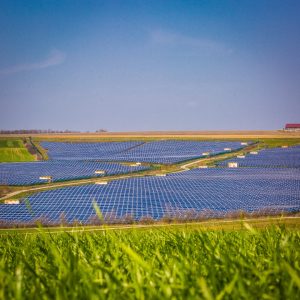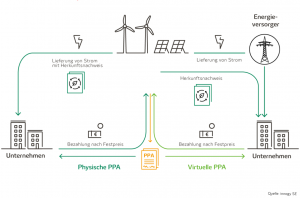 When dealing with renewable energy plants, the term “PPA” pops up again and again. The abbreviation PPA stands for “Power Purchase Agreement” and is a special form of a power supply contract, as you might enter into for your own home, as a private person, with an energy supplier, for example.
When dealing with renewable energy plants, the term “PPA” pops up again and again. The abbreviation PPA stands for “Power Purchase Agreement” and is a special form of a power supply contract, as you might enter into for your own home, as a private person, with an energy supplier, for example.
What exactly does a PPA look like? Related to a solar park in Germany, there is the for example the following configuration: the operator of a solar park sells the renewably produced electricity of the PV plant for a fixed price to a purchasing partner. The actual delivery of the electricity can, depending on the configuration and location, take place via a direct line or via the public grid – as shown in the illustration below.
But why does all this matter?
At times of very low legal remuneration rates for solar parks subject to mandatory tendering, the interest in alternative marketing opportunities is great. Plant operators and electricity consumers will be able to create a real win-win situation in the future. Plant operators hope that, in the medium term, such PPA electricity contract prices will exceed the rates of EEG remuneration. In turn, consumers will secure themselves a fixed price over a long contract term (e.g. 15 years), which can be very beneficial considering the current rising electricity prices.
A further advantage of a PPA is that the electricity consumer can include the purchased solar park electricity as 100-percent renewable in their (company’s) own energy footprint, which is great from an image perspective. 
Ultimately it is clear that an operational solar park must open itself up to new opportunities for electricity marketing. For many experts it seems to be only a matter of time before the first plant operators get involved in PPA opportunities with a type of “trial phase”.
Author: Andreas Hofmann (BA student, Projects Germany)